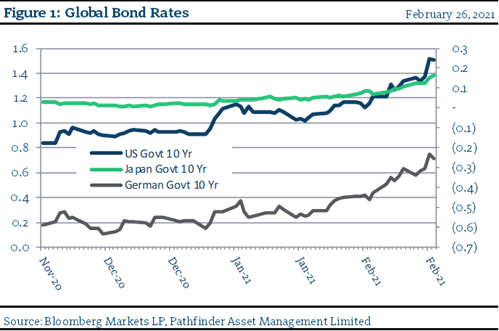Is Inflation Real?
We will dive right into the third part of our four-part series on inflation that should take us to the end of earnings season for Q4 2020. This topic seems to be more front and center in the financial press. Figure 1 presents a short-term chart for 10-year government bond yields so that you can see how quickly rates have increased from the recent bottom. With the equity sells of this week, rates have come back a bit but there is definitely a wall of worry about inflation. We have also added the Japanese and German 10-year bond yields (Japan is a 5-year high) to show that this is not just a US issue. As expectations for inflation increase, so does the rate of return that investors require on fixed income securities and this seems to be a global issue.

- We received good feedback from clients with respect to our last Investment Outlook, including real world commentary about businesses that are having a hard time finding raw materials and input components for their products and services. This seems to result in a “buy at any cost” strategy in order to get orders complete. If that is a common experience, then it is indeed inflationary and somewhat related to what we wrote about last week with respect to recent changes in inventory stocking levels and new corporate behavior because of the pandemic.
- One of the many items that we debate about around the desk is the validity of the data that are using to compare inflation over time. Christian Anthony, CFA who runs our Real Fund tracks several inflationary components in order to calculate a custom cost of living index. For Canadians, the cost of private education and housing have increased more than 50% since 2013. Gasoline and food, on the other hand, had dropped approximately 30% before the pandemic but have since rebounded back. In our daily lives, we often take note that goods and services have become more expensive, but we also have to keep in mind there are other things that have become very cheap. The supercomputer in your pocket (i.e., your smart phone) that is millions of times faster than the Apollo 11 guidance computers or the 40 inch TV at home on the wall are a fraction of what they used to cost.
“This means that” while there are blunt real-world examples of increasing prices, there are also other broad deflationary (i.e. technology) and inflation (i.e. monetary stimulus) forces at play. We will wrap up our series next week with our conclusions and present some details on the different strategic ways that we can use to adjust the portfolios to deal with the coming uncertainty.
National Instrument 31-103 requires registered firms to disclose information that a reasonable investor would expect to know, including any material conflicts with the firm or its representatives. Doug Johnson and/or Pathfinder Asset Management Limited are an insider of companies periodically mentioned in this report. Please visit www.paml.ca for full disclosures.
*All returns are time weighted and net of investment management fees. Returns from the Pathfinder Partners’ Fund and Pathfinder Real Fund are presented based on the masters series of each fund. The Pathfinder North American Equity Portfolio and The Pathfinder North American Income Portfolio are live accounts. These are actual accounts owned by the Pathfinder Chairman (Equity) and client (High Income) which contain no legacy positions, cash flows or other Pathfinder investment mandates or products. Monthly inception dates for each fund and portfolio are as follows: Pathfinder North American Equity Portfolio (January 2011), Pathfinder North American High-Income Portfolio (October 2012) Pathfinder Partners’ Fund (April 2011), Pathfinder Real Fund (April, 2013), and Pathfinder International Fund (November 2014).
Pathfinder Asset Management Limited (PAML) and its affiliates may collectively beneficially own in excess of 10% of one or more classes of the issued and outstanding equity securities mentioned in this newsletter. This publication is intended only to convey information. It is not to be construed as an investment guide or as an offer or solicitation of an offer to buy or sell any of the securities mentioned in it. The author has taken all usual and reasonable precautions to determine that the information contained in this publication has been obtained from sources believed to be reliable and that the procedures used to summarize and analyze such information are based on approved practices and principles in the investment industry. However, the market forces underlying investment value are subject to sudden and dramatic changes and data availability varies from one moment to the next. Consequently, neither the author nor PAML can make any warranty as to the accuracy or completeness of information, analysis or views contained in this publication or their usefulness or suitability in any particular circumstance. You should not undertake any investment or portfolio assessment or other transaction on the basis of this publication, but should first consult your portfolio manager, who can assess all relevant particulars of any proposed investment or transaction. PAML and the author accept no liability of any kind whatsoever or any damages or losses incurred by you as a result of reliance upon or use of this publication.